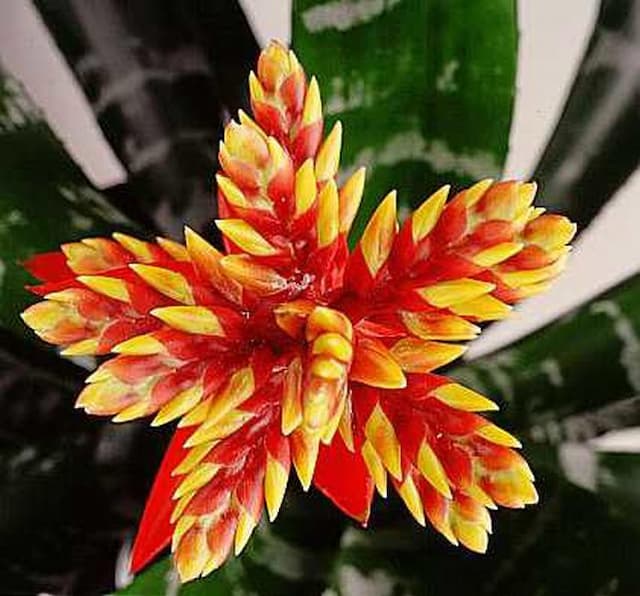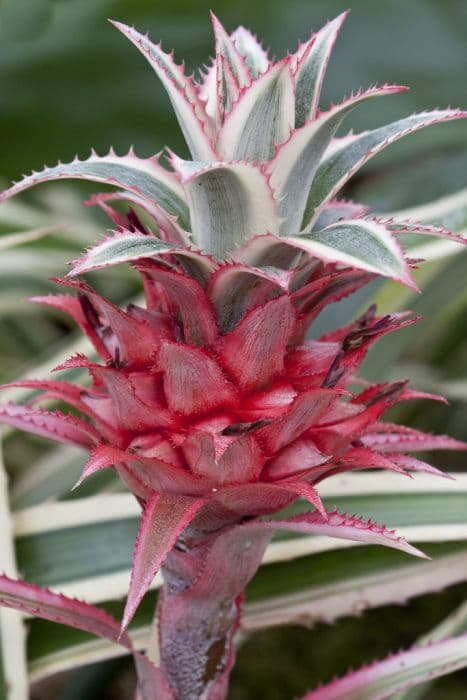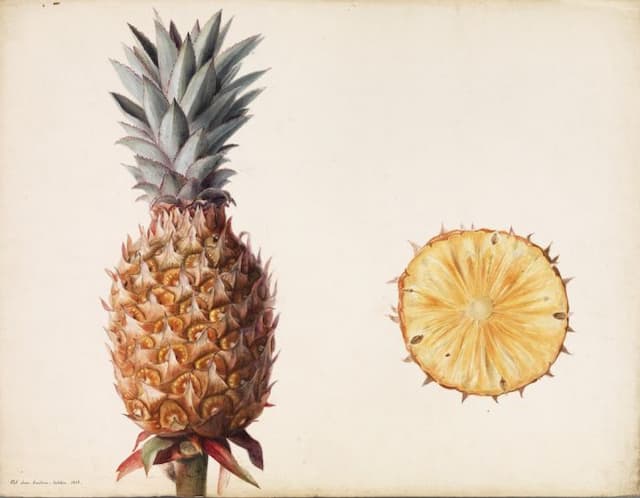Silver Air Plant Tillandsia argentea

ABOUT
Tillandsia argentea, commonly known as the silver air plant, is a unique and attractive specimen. It is characterized by its tufted, silvery-white foliage that can give a frosted or metallic luster, making it stand out among other green plants. The leaves are thin, needle-like, and tend to curl, creating a dense and intricate ball of soft strands. This air plant typically has a symmetrical and spherical shape, with leaves spreading out in all directions from the center. The silver air plant is an epiphyte, meaning it doesn't require soil to grow and gets its nutrients from the air and rainfall. Small roots may be present, but they serve primarily for anchoring the plant to its support rather than for nutrient absorption. The delicate leaves contain specialized cells that can absorb water and nutrients directly from humid air. When in bloom, the silver air plant produces delicate and vibrant flowers that are a striking contrast to the muted tones of its leaves. The flowers usually emerge from the center of the plant, adding a pop of color to the silvery foliage. These blooms can be quite appealing, although they are not integral to the plant's beauty, which lies primarily in its foliage. Overall, the silver air plant offers a unique visual texture and color, making it an ideal choice for anyone looking to add an exotic and otherworldly touch to their collection of houseplants or to design airy and minimalistic spaces. It's adaptive and can thrive in a variety of indoor environments, provided there's ample air circulation and indirect light.
About this plant
 Names
NamesFamily
Bromeliaceae
Synonyms
Silver Tillandsia, Air Plant
Common names
Tillandsia argentea
 Toxicity
ToxicityTo humans
Tillandsia argentea, commonly known as the silver air plant, is not known to be toxic to humans. Generally, this plant is considered safe, and there are no well-documented reports of poisoning or adverse effects from ingesting any part of this plant. However, it is always advisable to avoid eating ornamental plants due to potential individual allergies or gastrointestinal discomfort.
To pets
The silver air plant is considered non-toxic to pets. There are no common reports of illness or poisoning in pets such as dogs and cats from ingesting the plant. However, as with humans, it is generally best to prevent pets from chewing on ornamental plants to avoid any potential gastrointestinal upset or unexpected allergic reactions.
 Characteristics
CharacteristicsLife cycle
Perennials
Foliage type
Evergreen
Color of leaves
Silver
Flower color
Purple
Height
0.5 feet (15 cm
Spread
0.5 feet (15 cm
Plant type
Bromeliad
Hardiness zones
9
Native area
Central America
Benefits
 General Benefits
General Benefits- Low Maintenance: Tillandsia argentea, commonly known as silvery air plant, does not require soil, so it's easy to care for and is a great choice for anyone with a busy lifestyle or who is new to plant care.
- Adaptable Decor: With its unique appearance, the silvery air plant can be incorporated into a variety of decorative styles and can be displayed in innovative ways, such as in terrariums, on driftwood, or in hanging glass globes.
- Humidity Tolerance: This plant thrives in humid conditions, making it a suitable option for decorating bathrooms or other moist environments in the home or office.
- Drought Tolerant: The silvery air plant can withstand periods of drought because it can absorb moisture from the air through its leaves, meaning it requires less frequent watering than many other plants.
- Non-Toxic: It's a safe plant to keep around pets and children, as it is not toxic if accidentally ingested.
 Medical Properties
Medical PropertiesThis plant is not used for medical purposes.
 Air-purifying Qualities
Air-purifying QualitiesThis plant is not specifically known for air purifying qualities.
 Other Uses
Other Uses- Tillandsia argentea, commonly known as Silver Air Plant, can be used in living jewelry, such as necklaces or earrings, where the plant serves as a decorative and living ornament.
- Embedded in clear resin, Silver Air Plant can be used to create unique botanical paperweights, showcasing its delicate structure in a functional art piece.
- Because of its small size and resilience, it can be used as a natural decoration for computer desks or workspaces, requiring little space and maintenance.
- As a natural decor for reptile or amphibian terrariums, Silver Air Plant can provide aesthetic value while being non-toxic and safe for many creatures.
- It can be incorporated into bridal bouquets or boutonnieres, adding an exotic and lasting element to wedding floral arrangements.
- Used as biodegradable confetti, the leaves or small parts of the Silver Air Plant can add a green touch to celebrations while being environmentally friendly upon decomposition.
- It can be affixed to personalized greeting cards or gift wrapping, serving as both a decoration and a bonus gift that can be cultivated afterwards.
- In photography, Silver Air Plant can be used as a delicate prop to add texture and interest to close-up or macro photography compositions.
- It can be used to create interactive educational materials for schools, teaching children about plants, ecosystems, and the basics of botany through hands-on experience.
- As part of a natural Christmas ornament, Silver Air Plant's silvery leaves can complement festive decorations without the worry of it withering quickly.
Interesting Facts
 Feng Shui
Feng ShuiThe Air Plant is not used in Feng Shui practice.
 Zodiac Sign Compitability
Zodiac Sign CompitabilityThe Air Plant is not used in astrology practice.
 Plant Symbolism
Plant Symbolism- Independence: As an air plant, Tillandsia argentea does not require soil to grow, symbolizing self-sufficiency and the ability to thrive independently.
- Freedom: This plant's ability to grow without being rooted in the earth represents freedom and non-conformity.
- Adaptability: Tillandsia argentea's versatile nature of growing in various conditions reflects adaptability and resilience.
- Uniqueness: Its distinctive growth style and appearance symbolize uniqueness and encourage embracing individuality.
 Water
WaterThe Silver Ball Moss should be watered by misting thoroughly several times a week, depending on the humidity of its environment. In drier conditions, misting daily may be necessary, whereas in more humid environments, misting three times a week can suffice. During each misting session, ensure the plant is evenly covered but not saturated. Depending on the plant's size and the ambient humidity, typically use about 1 to 2 ounces of water. If the air is particularly dry, soaking the plant in water every two to four weeks for no more than an hour can help maintain its moisture needs.
 Light
LightThe Silver Ball Moss thrives under bright, indirect light, making it perfect for east or west-facing windows where direct sunlight is limited. Avoid placing this air plant in direct sunlight for extended periods to prevent sunburn. A shaded spot that receives dappled sunlight throughout the day would be ideal, as it simulates the light conditions of its natural habitat.
 Temperature
TemperatureThe Silver Ball Moss prefers temperatures between 50 and 90 degrees Fahrenheit. It can survive minimum temperatures of about 35 degrees Fahrenheit but should not be exposed to frost or temperatures below freezing. Ideally, maintain an environment that's consistently warm without drastic temperature swings to ensure the health of this air plant.
 Pruning
PruningPruning the Silver Ball Moss is generally not required, as it maintains a compact form naturally. If any dead or brown leaves appear, they can be gently removed by hand to keep the plant looking tidy. The best time for pruning, if necessary, is during the plant's active growth period in the spring and summer.
 Cleaning
CleaningAs needed
 Soil
SoilThe Silver Ball Moss, as Tillandsia argentea is commonly known, is an air plant and does not require soil. A soil mix is not necessary for its growth; instead, it absorbs moisture and nutrients from the air. The pH of the soil is therefore irrelevant for this plant.
 Repotting
RepottingThe Silver Ball Moss does not require repotting as it does not grow in soil. It is an epiphytic plant, often growing on other plants or objects and absorbs nutrients and water from the air.
 Humidity & Misting
Humidity & MistingThe Silver Ball Moss thrives best in high humidity conditions, generally above 50%. Maintaining good air circulation and misting the plant regularly can help achieve these humidity levels.
 Suitable locations
Suitable locationsIndoor
Mount on wood or place in a bright area, mist frequently.
Outdoor
Hang or mount in partial shade, shelter from heavy rain.
Hardiness zone
9-11 USDA
 Life cycle
Life cycleThe life of Tillandsia argentea, commonly known as air plant, begins with seed germination, where seeds develop on the parent plant and are dispersed by the wind due to their lightweight and feathery appendages. After landing on a suitable substrate, often in the crooks of tree branches or crevices in rocks, the seed germinates, and the plant starts to develop a small rosette of leaves from which it absorbs water and nutrients directly from the air and rainfall. As the plant matures, it forms a tighter rosette and may produce offsets or "pups" at its base, which will grow independently and ensure the next generation. The air plant will eventually bloom only once in its lifetime, producing brightly colored bracts from which small, delicate flowers emerge. After flowering, often over several months, the plant will gradually decline as its energy goes into producing seeds and pups before it dies. The life cycle continues as the pups grow and eventually mature to repeat the process.
 Propogation
PropogationPropogation time
Spring-Early Summer
Propogation: The most popular method of propagation for the Tillandsia argentea, commonly known as the Silver Air Plant, is through the division of offsets, also known as "pups." These pups are small clones that form at the base of the parent plant. Once a pup reaches about one-third the size of the parent plant, which typically occurs after the parent has flowered, it can be separated carefully by hand or with a sharp knife, ensuring to not damage the base of the pup. The best time to propagate is during the growing season, which is spring and summer. After separation, the pups should be placed in a bright area with good air circulation to allow any wounds to heal over a few days. Then, they can be mounted or placed in their desired location, where they will grow into mature air plants.









